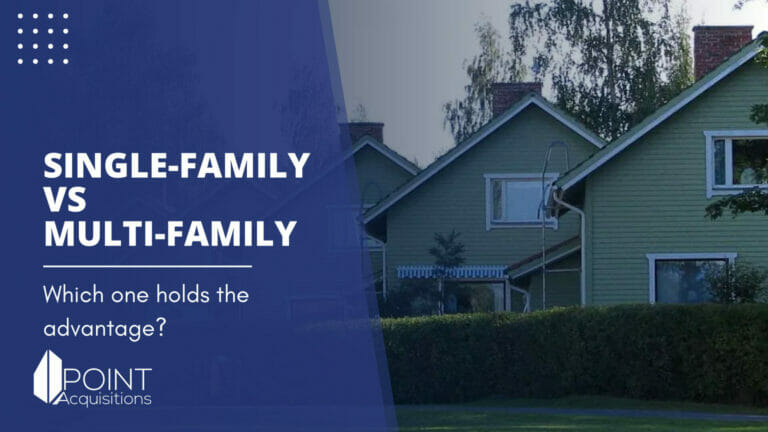
Single-Family Vs. Multi-Family Investing: Which Is Better?
The real estate investment landscape consists of seemingly limitless options regarding which properties to focus on and how much to invest in them. One of the fundamental choices presented to a would-be investor is whether it is more feasible to invest in residences created for use by a single-family (“single-family” properties), or residences designed with the capacity to house multiple families, separately, in a single structure (a “multi-family” property.).
While both options have their attractive points – investing in single-family homes, for instance, is a more manageable choice for a beginning investor, while multi-family properties may be better suited for someone with more experience and investment capital – the ultimate answer depends upon the investor’s financial status, their experience and comfort with the client, and the state of the properties themselves.
This post aims to help any prospective investor make a decision on which type of property suits their investiture best by detailing the differences between a single-family and multi-family unit and the benefits and challenges presented by both.
Table of Contents
The Difference Between Single-Family vs. Multi-Family Properties
The potential investor might be wondering what differentiates a single-family house from a multi-family property. This is not as simple as it sounds: would, for instance, a large mansion with multiple bedrooms be considered a “multi-family” property, even if it was purpose-built as a private, single-family residence? Would a small apartment building housing two separate families of in-laws still be considered “single-family?” These seemingly simple questions can have significant consequences for investors who haven’t properly educated themselves on a given property. Let’s start by breaking down what constitutes a “single-family” vs. a “multiple-family” home and the pros and cons of each.
What are Single-Family homes?
A single-family home is, simply put, one property that contains a singular residence. This means it has been purpose-built to house one family (generally, about four or five people) and one family only. A single-family home can be anything from a small cabin in the woods to a large two-story house in the suburbs; what constitutes its status as a single-family is its capacity for a relatively small amount of people to occupy it comfortably.
In almost all cases, a single-family home is your standard detached residence; one to two bedrooms, one kitchen, one set of appliances (such as refrigerators or washing machines), one private entrance, parking space for one or two vehicles at the most, and utility meters. This is usually all that is required to comfortably (and safely) house a family of four or five individuals, both in terms of physical space and comfort, but also in terms of things like water, gas, and electricity usage.
What are Multi-family homes?
A multi-family home, in brief, is a property that contains multiple separate living spaces, or “units,” under one roof or within a larger superstructure, consisting of separate kitchens, appliances, living and sleeping quarters, and utility meters for each individual unit.
There may be two (duplex), three (triplex), four (quadruplex), or more units in one main property or an entire building with different units. With multi-family properties, the actual size and shape of a multi-family home matter less than its ability to house more than one family at any given time easily.
Multi-family homes enable tenants of each unit to live separately from their neighbors, even though they might share a wall, roof, garden, or common areas.
Although each family is responsible for maintaining their separate living spaces – using water responsibly, for instance – the communal aspect of such a property cannot be underestimated, as residents can usually be counted on to support one another, loan one another useful items such as snow shovels or extra batteries, and report issues with the property faster.
Value of single-family vs multi-family homes
Single-family homes are usually valued based on comparable sales in the area, with similar properties being considered for their resale value. Single-family homes are the best choice for real estate investors who want to make a low-risk investment with potentially high returns, as they are known to appreciate in value over time.
Whereas multifamily properties will be valued by sales/unit comps as well as the current and future cash flows of the property. Multifamily investors will typically look at the overall value of the property, and factor in things like future appreciation, cash flow, and net operating income (NOI).
The main reasons that some investors prefer one over the other are convenience, comfort, and cost. Let’s take a look at each of these factors in some further detail to get a better idea of why many investors prefer either single- or multi-family homes.
Financing single-family homes vs multi-family homes
In terms of financing, single-family homes are generally easier to finance than multi-family properties.
Single-family homes are easier to finance as a result of their ‘one family’ status, as they are easier to resell if need be. On the other hand, multifamily homes have lower resale value because it is difficult to find purchasers for multiple units at once.
In addition, single-family homes typically enjoy more lenient financing terms than multifamily properties; whereas a single-family home may be bought with a 20% cash down payment, a multifamily property may require as large as 33% or more.
In terms of the mortgage market’s perception of risk and reward, single-family homes are seen as lower-risk propositions (and thus subject to more lenient financing terms) than multi-family properties.
Learn more about real estate financing in our blog about Leverage For Real Estate.
Single-Family Home Investment
Now that we have defined the differences between single-family and multi-family properties let’s discuss the benefits and drawbacks of investing in each, beginning with single-family units. Single-family properties are best suited for investors who want to take their time scaling up, as it allows for more space and resources, especially at a lower price point, before getting into more significant deals. However, there is also less room for expansion with units of this type, and vacancies are more costly.
Lower your initial investment with single-family homes
Simply put, single-family homes are a popular option for new investors because they require less money. Due to the low cost of outfitting the property, a return on investment is more likely.
More privacy, more space, and more freedom
When purchasing and renting single-family home rentals, you will most likely have more space and privacy than a multi-family space, two desirable options for buyers or renters.
Investing in a single-family home also means more flexibility in furnishing or customizing the property and grounds to the investor’s – or the client’s – specifications. Lastly, single-property homes encourage long-term settlement on the part of the renter or buyer. Therefore, properties of this type have fewer vacancies.
Fewer vacancies but heavier loss when the single-family home is vacant
One of the biggest concerns that new investors must realize when owning a single-family property is that they are more time-sensitive; finding a new replacement quickly is paramount if one tenant leaves. Since you only have one tenant when they decide to no longer rent the space you have zero income.
Costs of upkeep – including compliance with city or town ordinances, as well as regular maintenance – can quickly compound. As mentioned, single-family homes typically suffer from fewer vacancies. However, your losses may be steeper if your single-family property is vacated without a timely replacement.
Less rental income with one single-family property
Additionally, the investor must realize that as the property only supports one family, they only have one source of income to depend on, instead of a multi-family property with multiple sources of revenue such as rent, parking permits, and utility bills. Therefore, a single-family property may not be the best fit for investors aiming for a significantly high return on investment (ROI) in the short term.
However, your single-family property may be located in a relatively expensive area with high rents and living costs – such as downtown Manhattan, the Miami waterfront, or the San Francisco Bay Area. This can offset the singular nature of the investment by ensuring that the cost of renting, buying, and maintaining the unit on the client’s part stays high.
Harder to expand
If the single-family home investor wishes to invest in multiple single-family homes, they must be aware that each property will require individual time, attention, and research. The considerations or complaints of each renter or buyer of these properties will be unique and not able to easily be solved with one “blanket” solution.
For instance, if the homes are located in two separate areas of town, they may be serviced by two separate wireless internet/telecom companies, both of which the investor will have to negotiate contracts with separately. Compare this with a multi-family unit, where many individuals often share the same wi-fi/phone service, requiring only one telecom company for the investor to deal with.
More attention to detail and maintenance is required with single-family homes.
Prospective renters or buyers of single-family homes are looking for clean, spacious, well-maintained environments. As a result, more attention to detail is required for these properties. Much of the responsibility falls on the investor for regular maintenance, inspection, protection, and beautification of the unit and surrounding grounds.
Single-family homes can also be challenging since any lapses in maintenance are more immediately noticeable. Anything from overgrown lawns to unpleasant smells can have an immediate and drastic effect on the property’s worth.
Easier to re-sell single-family homes
One of the benefits of investing in single-family properties is that the demand for them has never gone away; as individuals mature and as families grow, the desire for privacy and comfort means that many aspire for a place of their own to rent or to buy outright.
Even today, with declining birth rates and less premium put on marriage and cohabitation, single-family homes continue to be eagerly sought out. They are usually rented or mortgaged shortly after being put on the market.
Although, as mentioned, a unit that stays empty for an extended period can be a significant financial drain, once resold, that unit usually is a net gain on one’s investment due to any improvements or refurnishing put in place during the previous tenant’s occupation. Additionally, due to the current high inflation rates in the real estate market, property values generally trend upward over time.
Multi-Family Home Investment
Now that we have articulated some of the benefits and drawbacks of single-family home investment, we can focus on the different aspects of multi-family home investment. This option presents a range of challenges, but it may be an attractive first-time investment opportunity for many depending on the situation.
Higher initial investment with multifamily rental properties
Most importantly, multi-family properties represent a higher initial cash investment than single-family counterparts. Since there are multiple units to maintain, maintenance costs go up. Additionally, there may be some expenses unique to multi-family units, such as purchasing and installing equipment to comply with fire safety ordinances.
Ideal for families or friends who want to live close to each other
Multi-family properties are, as one would expect, extremely attractive to extended families or friend groups who wish to live close to another without sacrificing their independence. By offering the property to pre-existing social groups, the investor can fill up multiple units quickly, even simultaneously.
This also reduces the risk of any “bad neighbor” complaints, as these groups can also usually resolve conflicts or solve problems without needing external assistance from the property owner.
More rental income with multifamily rental properties
Since multiple tenants equate to multiple sources of income, multi-family homes allow for a more significant return on the initial investment. Generally speaking, the more tenants a property has, the easier it will be to cover costs and turn a profit. Even if one unit is vacated suddenly, the investor is still relatively protected from losses by other tenants until the vacant unit can be filled again.
Harder to manage as there are multiple rental units
However, dealing with multiple tenant groups means dealing with multiple sets of issues. For instance, an east-facing apartment unit may have more issues with sun glare during the morning hours and may request heavier curtains or blinds than a south-facing unit. This also might affect the unit’s air conditioning and ventilation needs in the summer since it would get hotter quicker than other units on the property.
In addition to each unit having its own unique maintenance challenges, it is crucial to keep in mind that its tenants may have their own personalities with which the investor, property manager, or landlord will have to contend. A “one size fits all” approach to dealing with multiple-family renters is not advisable.
More maintenance and property management
Multi-family homes, especially properties that physically cover a lot of space, tend to require more regular maintenance than single-family homes. Each unit contains its own appliances, fixtures, and systems such as electricity and water, which must be kept in top shape.
Investors can hire a management company or property manager to help with this or pay a landlord to stay on-site and deal with any issues as they arise. Still, it is a given that investors will need to dedicate more time, money, and attention to maintain a multiple-family property as an attractive and liveable space.
Less private space
Although each unit in a multiple-family property is ostensibly self-sufficient – meaning it contains its own kitchen, bathrooms, etc. – there will still likely be spaces that are considered communal, such as common rooms, parking lots, fitness or exercise rooms, and throughways such as lobbies and courtyards.
Proper management of these spaces is essential to keep the property attractive and clean and minimize conflict between tenants. Although most tenants in multiple-family dwellings understand and accept this sharing of certain spaces, some may value privacy above others and resent what they might perceive as intrusions into their spheres of influence.
Issues such as litter or graffiti left in common areas, visitors parking in spaces reserved for tenants, or misuse of workout equipment can become serious issues if it leads to conflict between tenants or the vacating of a unit due to the tenant’s displeasure.
Single-Family vs. Multi-Family Real Estate Investing: Final Decisions
Ultimately, as is often the case, choosing to manage and invest your money is a very personal decision. Many debates may occur because one individual benefitted from one option while others succeeded.
The truth is, there is no one “guaranteed” way to successfully invest in property and generate a tremendous rate of return. This document hopes to help the potential investor distinguish which type of property might best fit their particular financial situation, personal experience, and capabilities.
An investor who has done their due diligence by comparing and contrasting these two types of property, as well as having researched the property itself – its strengths, weaknesses, value, and cost – will be much better equipped to make an impactful, lasting decision.
This will benefit themselves and their future tenants, homeowners, and clients.
Confused about investing in real estate? Let us take the guesswork out of it. Contact us for more information.
About The Author

Jesse Shemesh
Disclaimer
Please note that Point Acquisitions is not a tax expert or tax advisor. The information on our blogs and pages is for general informational purposes only and should not be relied upon as legal, tax, or accounting advice. Any information provided does not constitute professional advice or create an attorney-client or any other professional relationship. We recommend that you consult with your tax advisor or seek professional advice before making any decisions based on the information provided on our blogs and pages. Point Acquisitions is not responsible for any actions taken based on the information provided on our blogs and pages.
1031 Exchange Capital Gains Tax Deferral
According to a 2021 report by the National Real Estate Exchange Services (RES), over 240,000 1031 exchange transactions were completed in the United States, totaling $100 billion. This impressive figure underscores the role of 1031 exchanges in the real estate…
Read More1031 Exchange Benefits
As of Q4 2023, the national vacancy rate for all commercial property types in the United States sat at 9.2%, according to CBRE’s latest insights and research. This represents a slight decrease compared to the previous quarter and suggests a…
Read More1031 Exchange Legal Considerations: A Must-Read Guide
You’re in the right place if you’re considering a 1031 exchange for your commercial real estate investments. Whether you’re a seasoned investor or just dipping your toes into the market, understanding the legal landscape of 1031 exchanges is key to…
Read More

